Washington
| |
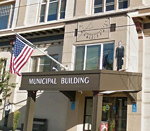 |
Anacortes |
Washington |
USA |
Vertical Dial |
Dial 212 |
| A vertical dial 4 x 8 feet on marine plywood painted the same color as the building. An aluminum rod gnomon casts the shadow, supported by a copper strut of plumbing pipe. Early photos show dial with no hour lines. By 2017, short hour and half hour lines added near the Arabic hour marks. Both form a semicircle around the gnomon, telling time from 7am to 6pm. |
| |
| |
 |
Bellingham |
Washington |
USA |
Vertical Dial |
Dial 915 |
| The vertical dial is incorporated into a bright, flowing mural 29 x 54 feet covering nearly all of the south wall of a brick building. The mural was several years in the making. It began with an international competition sponsored by Allied Arts of Bellingham and sundial enthusiast Sasch Stephens. Ultimately the mural with embedded vertical dial was dedicated on the fall equinox. Called the "First Shadow Celebration" many local celebrities recognized the new mural artwork and old art of sun dialing. |
| |
| |
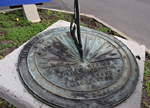 |
Bremerton |
Washington |
USA |
Horizontal Dial |
Dial 1078 |
| Farenholt sundial for U.S. Naval Hospital Puget Sound Washington. This cast bronze dial was designed and commissioned by RADM Farenholt for U.S. Naval Hospitals at bases where he was commanding officer, visited, or had special meaning to him. The dial is 18 inches (46cm) in diameter. The outer chapter ring has the motto, followed by a chapter ring with Arabic hours 6am to 6pm, raised hour lines that radiate from near the foot of the gnomon and short half-hour lines. The gnomon has graceful curves and a trefoil cut-out in the center. Below the gnomon is the naval command name, followed by the commissioning date in the southern portion of the hours chapter ring. |
| |
| |
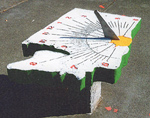 |
Everett |
Washington |
USA |
Horizontal Dial |
Dial 1137 |
| A concrete dial in the shape of the state of Washington, about 30 x 50 in (76 x 127 cm). Radiating from the stainless-steel gnomon are 48 hour lines, providing time lines every quarter hour from 6am to 6pm. Hours are Arabic numbers at the end of hour lines that vary in length throughout the state. Galvanized and painted black are markers for the cities of Vancouver, Olympia, Tacoma, Seattle, Everett, Bellingham, and Spokane. The dial sits on a concrete pillar 23 in (59 cm) tall. |
| |
| |
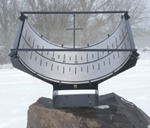 |
Goldendale |
Washington |
USA |
Cylindrical Dial |
Dial 242 |
| The sundial has a 53-inch semicircular steel equatorial ring and is 18-inches wide. The 18-inch rod gnomon is suspended above the dial by two horizontal rods. A small cross-bar in the middle of the gnomon acts as a nodus for telling the date. A mechanical adjustment allows for the equation of time correction. The dial is mounted on a large boulder on the Northwest end of the Goldendale Observatory close to the Solar Telescope Building. |
| |
| |
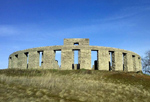 |
Maryhill |
Washington |
USA |
Sun Alignment |
Dial 241 |
| The Maryhill Stonehenge was the first monument in the US to honor the dead of World War I. It is 180-feet across with pillars of reinforced concrete, duplicating, as nearly as possible the original size and design of Stonehenge. The outer circle has thirty 16-foot pillars while the inner circle has forty pillars 9-foot high. Build by a wealthy entrepreneur Sam Hill as a memorial to servicemen of Klickitat County. |
| |
| |
 |
Ocean Shores |
Washington |
USA |
Horizontal Dial |
Dial 842 |
| This large horizontal dial has a gnomon in the shape of an anchor and concrete minimalist dial surface in the shape of a triangle, keeping the theme of the location "Triangle Park". Three time Arabic hour numbers of 9, 12 and 3 are embedded into the concrete slab and two other time marks of 6am and 6pm are on separate pads located outside the main dial area. |
| |
| |
 |
Olympia |
Washington |
USA |
Horizontal Dial |
Dial 319 |
| John W. Elliot, a Seattle master craftsman designed and execute the Territorial Sundial. The 6 foot dial is hand-hammered in brass with a bronze rod gnomon. The dial plate has eight bas-relief panels depicting events in Washington State's history including the discoveries of Captain George Vancouver in 1792, the Medicine Creek Treaty between the US and Puget Sound Native Americans in 1854 and the first railroad to Puget Sound, built in 1883. The dial rests on a large slab of Wilkenson sandstone, the same material used in the nearby State Library, supported by four, one foot nine inch tall piers. |
| |
| |
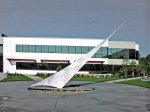 |
Renton |
Washington |
USA |
Horizontal Dial |
Dial 524 |
| A 44 x 60 foot horizontal dial with 20 foot tall stainless steel gnomon. This may be the largest horizontal dial in the state of Washington. Five colors of concrete define distinct parts of the dial and pathways (the 8 o?clock and 5 o?clock hour lines are walkways between buildings). Other hour lines have concrete benches and stainless steel discs to mark each hour, plus inlaid bronze discs for daylight saving time.
Hour lines have inset disks to indicate the hour, one disk for each counted hour 6 AM to 7 PM. The mid-day N-S hour line features thirteen hour disks; the previous hour has 12 disks and the next hour is marked with two disks. The N-S hour line may include one disk that is also a light to illuminate the gnomon at night. |
| |
| |
 |
Seattle |
Washington |
USA |
Vertical Dial |
Dial 744 |
| A 10 x 18 foot vertical dial on a south-facing brick wall. The hour lines are stainless steel sheet and are formed to create shadow effects that change with the position of the sun. The stainless steel Arabic hour numerals are on disks that are held on the wall by magnets, allowing them to be placed for ST or DST. A stylized school emblem is placed at the base of the gnomon. A round, two-sided plaque in the wall below describes the use of the dial, designed by Mindy Cameron of Lehrman Cameron Studio. |
| |
| |
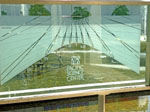 |
Seattle |
Washington |
USA |
Vertical Dial |
Dial 795 |
| A 4 foot wide by 1.5 foot high etched glass plate vertical dial. The gnomon is formed by crossed bars several inches behind the plate and casts its shadow on hour line analemmas. Roman hour numerals for 10 AM to 4 PM are scribed under each analemma; other hours are Arabic. Solstice and equinox lines are scribed across the plate, as are narrow lines at 10 day intervals. Months of the year are scribed about the plate perimeter. A description of the dial is marked on the left side of the plate and the fountains are visible through the plate |
| |
| |
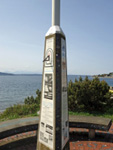 |
Seattle |
Washington |
USA |
Vertical Dial |
Dial 791 |
| A south facing vertical dial on a chamfered triangular pillar. The gnomon is slightly bent. The dial face includes hour lines with Arabic numerals for Pacific Standard Time and PDT, the approximate coordinates and the magnetic declination. |
| |
| |
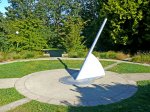 |
Seattle |
Washington |
USA |
Horizontal Dial |
Dial 748 |
| A 35 foot diameter horizontal dial of concrete and stainless steel with an 8 foot gnomon. Hour marks and Arabic hour numerals are shown on the inner circle and outer ring. A meridian line has markers for solstices and equinoxes, for cardinal directions and magnetic bearings. The dial was constructed using material obtained from Boeing Surplus. |
| |
| |
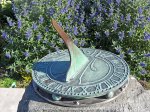 |
Seattle |
Washington |
USA |
Horizontal Dial |
Dial 747 |
| A 20 inch diameter cast bronze horizontal dial atop a 30 inch high one-piece stone pedestal. The dial face has cast quarter-hour marks and Roman hour numerals. The dial, built in 1912, has been refurbished and relocated several times and has a new bronze gnomon. Prof. Woody Sullivan and Kurt Kiefer did the last restoration in 2002. Dial times are inaccurate 5-7 minutes. |
| |
| |
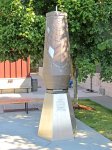 |
Seattle |
Washington |
USA |
Cylindrical Dial |
Dial 746 |
| A unique, 10 foot tall, 2 foot diameter (base) tapered cylinder dial similar to a traditional shepherd's dial except that the cylinder orientation is fixed and the gnomon is rotated about the dial axis by the user to align with the sun. Time is read from the vertical hour and date lines. The dial is fabricated from bronze plate and is hollow. Lines are formed by individually cut hour and date line segments welded on from inside the cylinder. A lever at hand height is moved to rotate the gnomon to face the sun, providing a vertical shadow. A slit in the gnomon tip provides a more accurate sun spot on the dial face. The cylinder is tapered top to bottom for aesthetics and to minimize the effect of solar altitude variation through the seasons. |
| |
| |
 |
Seattle |
Washington |
USA |
Vertical Dial |
Dial 745 |
| A 12 x 30 foot vertical dial on a brick wall that declines 0.5? west of south. The 5 foot stainless steel gnomon tip carries a sheet metal sculpture of an eagle, the school mascot. The hour lines are aluminum strips terminating in Arabic hour numerals. The dial face includes ceramic disks painted by school students and are placed so that the gnomon shadow falls on then on their birthday. |
| |
| |
 |
Seattle |
Washington |
USA |
Analemmatic Dial |
Dial 74 |
| 27-ft (8m) circle containing a fanciful analemmatic dial made of bronze and concrete with countless embedded items. Seattle Sundial Trails notes "It requires more than a casual look to recognize the paving that tops Kite Hill as a sundial. At first glance, it seems as if the high tide washed over a bed of fresh concrete, leaving lots of marine creatures and wave prints behind.....The structure is colored concrete, with many interesting inlaid objects scattered throughout, including a bronze bear claw, a ceramic crab, pieces of pottery and glass and shells, etc. Many features are in bronze (such as some hour numerals and the [zodiac walkway] on which one stands.... Bronze casts of three pairs of footprints are those of Greening, the (anonymous) donor of the piece, and the donor’s dog! There are, however, so many inlaid objects and the hour numerals are so stylized that the dial pattern is somewhat obscured." At the center of the dial is a large yin-yang symbol, made from light and dark concrete. Within this is the zodiac walkway to stand for casting the hour's shadow. However normal dates have given way to elongated bronze band loops around a wavy center line using zodiac signs to indicate the months. For example: Equinoxes are indicated by Aries and Libra while the summer solstice is the Tropic of Cancer and winter solstice is Tropic of Capricorn. |
| |
| |
 |
Seattle |
Washington |
USA |
Gnomonic or Projection Dial |
Dial 577 |
| A colored-aperture projection calendrical sundial with one functional and four decorative 18 inch round clear stained glass apertures. Markings on floor indicate positions of projected orange light spot at solar noon from the spring to fall equinox. An additional noon mark indicates opening date of library. |
| |
| |
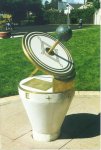 |
Seattle |
Washington |
USA |
Equatorial Dial |
Dial 315 |
| An interesting equatorial dial 30 inches in diameter, made of bronze and terrazzo, sitting upon a tapered concrete pedestal cylinder that almost, but not quite, looks like a large flower pot. The dial plate is plainly decorated with a gnomon pole about 1.5 inches in diameter. Sitting at the north end of the pole is a very nice globe of the earth with continents in relief. |
| |
| |
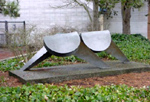 |
Seattle |
Washington |
USA |
Sculpture/Artwork |
Dial 306 |
| 3x9x4 feet cast bronze sculpture of two gibbous shaped circles, each with supports. The sculpture called "Gnomon" could have been better called "abbreviated millipede" |
| |
| |
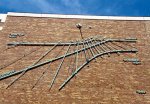 |
Seattle |
Washington |
USA |
Vertical Dial |
Dial 117 |
| Large vertical dial declining 36? west of south with hour lines, analemmal lines, sunrise and sunset limits, solstice lines. Metal structure mounted slightly away from brick building surface. Gnomon is a ball mounted on a rod emanating from sunburst. Visit the university of Washington web page to see this beautiful dial. |
| |
| |
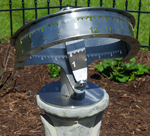 |
Sequim |
Washington |
USA |
Digital Dial |
Dial 1122 |
| This dial began as a Thewes Sundial with an equatorial arc with cut out hour numbers that illuminate a central plate. This original dial went missing in the 1970's.. But when the new stainless steel sundial with a 150mm radius equatorial arc was finished, it took the Thewes concept into the 21st Century. The equatorial arc not only has the hourly Arabic numbers, but has a row of finely cut marks every five minutes with very easily distinguishing shapes to see the hour, half, and quarter hour indicators. And rather than a central plate tilted to the site's latitude, this dial has a plate that rotates on the polar axis set at the center of the equatorial arc. |
| |
| |
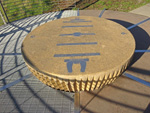 |
Shoreline |
Washington |
USA |
Analemmatic Dial |
Dial 796 |
| An 8 foot diameter concrete and pebble analemmatic dial with engraved stainless steel inserts for central date line and simple instructions for use. The dial face is raised one foot on a fluted column above the perimeter concrete and stainless steel walkway and has stainless steel Arabic hour numerals for 6 AM, 12 PM and 6 PM. The walkway has stainless steel inserts showing hour lines, magnetic north, true north, winter solstice, equinox and summer solstice directions. |
| |
| |
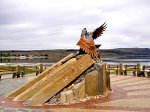 |
Soap Lake |
Washington |
USA |
Sculpture/Artwork |
Dial 652 |
| A monumental, 1-1/3 life-size bronze, steel and basalt rock sundial sculpture of a human figure with raised arm serving as a gnomon. The sculpture, "Calling the Healing Waters," depicts a young Native American couple as Father Sky and Mother Earth, sacred essence of rain and minerals connecting and bringing healing. Reflecting ethnic and historical themes, the winged warrior protects and comforts the maiden holding a catch basin for the healing waters. The sculpture was commissioned to honor the healing properties of the waters of Soap Lake. |
| |
| |
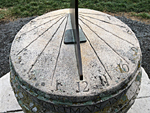 |
Spokane |
Washington |
USA |
Horizontal Dial |
Dial 1074 |
| The stone dial is approximately 24 inches (61 cm) in diameter with a large brass gnomon whose foot is considerably offset to the south. Simple hour lines with Arabic numbers from 7am to 5pm facing outward. The dial is approximately 2 inches (5 cm) thick with a band for inscription directly below. All this sits on a 12-sided pedestal of slightly larger diameter. On each slender side of the pedestal is an embossed sign of the zodiac. Lichens have taken hold on parts of the dial and pedestal. The sundial is a memorial to the two sons of Mr. and Mrs. R. Jackson Wortman. Jacob J. Wortman died at age 15 after a lingering illness. Ward K. Wortman, a fighter pilot in the Air Corps, was killed in action. |
| |
| |
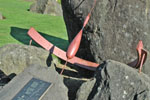 |
Stevenson |
Washington |
USA |
Equatorial Dial |
Dial 707 |
| An approximately four foot diameter equatorial ring dial of natural stone and steel with an analemmic gnomon. Equatorial ring has hour and 15 minute marks with Arabic numeral for PST and PDT. A plaque indicates how to read the shadow of the gnomon, shows primary directions and identifies the dial designer. Plaque includes an analemma showing the equinoxes and solstices and states the dial is accurate within 2 minutes year around. Since the dial includes an analemmic gnomon, no application of EOT correction is needed. |
| |
| |
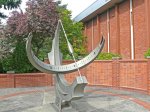 |
Vancouver |
Washington |
USA |
Equatorial Dial |
Dial 659 |
| A 2 meter diameter ring equatorial dial of welded anodized aluminum plate. The dial face shows Arabic numerals with hour and quarter-hour marks. This face can be moved for longitude correction and DST, and was originally adjusted to correct periodically for EOT. In 2009, the original straight gnomon was replaced with an analemmic gnomon, eliminating the need to adjust or correct for EOT. |
| |